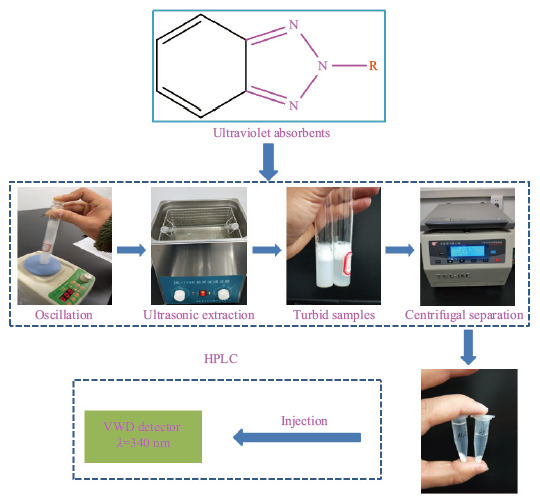A method for the determination of 2-(2-benzotriazolyl)-4-methylphenol(UV-P), 2-benzotriazol-2-yl-4-(1, 1, 3, 3-tetramethylbutyl)phenol(UV-329), 2-tert-butyl-6-(5-chloro-2H-benzotriazol-2-yl)-4-methylphenol(UV-326), 2-(benzotriazol-2-yl)-4-methyl-6-[2-methyl-3-[methyl-bis(trimethylsilyloxy)silyl]propyl]phenol(DTTSO) and 2, 2-methylenebis[6-(2H-benzotriazol-2-yl)-4-(1, 1, 3, 3-tetramethylbutyl)phenol](UV-360) in cosmetics by high performance liquid chromatography was established. Watery cosmetics were dissolved in methanol/tetrahydrofuran, ultrasonically extracted, and filtered by microporous membrane for injection. Emulsion and cream cosmetics were prepared by methanol/tetrahydrofuran dissolution, vortex oscillation, ultrasonic extraction, and microporous membrane filtration injection. The target chemicals were separated on ZORBAX SC-C18 column(250 mm×4.6 mm, 5 μm)using 0.1% formic acid, methanol and tetrahydrofuran as mobile phases and detected at 340 nm and 23 ℃. The flow rate of the mobile phase was 1.0 mL/min and the injection volume was 5 μL. The results show that the five benzotriazole ultraviolet absorbents have a good linear relationship in the mass concentration range of about 11-176 mg/L(R2≧0.999 4), the detection limits are 6.72, 11.94, 13.80, 18.47 and 23.49 μg/L, respectively, the relative standard deviation is less than 1.7%(n=6), and the average recovery rate is 93.7%-104.5%. The method is suitable for the determination of five benzotriazole ultraviolet absorbents in cosmetics.



